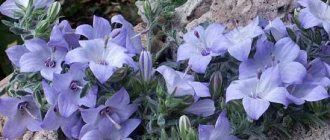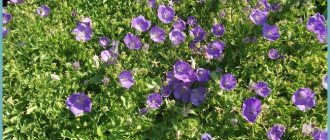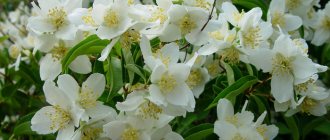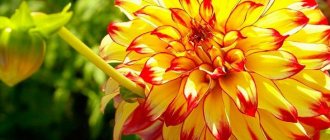Author: Elena N. https://floristics.info/ru/index.php?option=com_contact&view=contact&id=19 Category: Garden plants Published: February 27, 2019Last edits: January 20, 2021
- When to plant
- Growing conditions
- How and when to collect seeds
- Bluebell annual
flowers (lat. Campanula) belong to the genus of herbaceous plants of the Campanula family, which includes more than three hundred species growing in places with a temperate climate - in the Caucasus, Western and Central Asia, Europe, Siberia, and also in North America. Bells prefer steppes, meadows, forests, desert areas and rocks. Many species of these flowers grow in alpine and subalpine mountain belts. The Latin name is translated as bell. People call these flowers chenilles, chebotkas and bells.
Planting and caring for bells
- Planting: sowing seeds in open ground - in October or May. Sowing seeds for seedlings - in March, planting seedlings in open ground - at the end of May or at the beginning of June.
- Flowering: at different times - depending on the type and variety.
- Lighting: usually bright sunlight. There are only a few shade-loving species in the genus.
- Soil: any soil, even rocky and calcareous, but best drained loam with a neutral or slightly alkaline reaction.
- Watering: moderate and only in dry seasons.
- Staking: Tall varieties require support.
- Top dressing: on melted snow - with nitrogen fertilizer, during the budding period - with a complete mineral complex.
- Reproduction: annuals - only by seeds, biennials - by seeds and spring cuttings. Perennials can be propagated by parts of the rhizome, root cuttings, stolons, or dividing the bush, but when propagated by seed they do not retain varietal characteristics.
- Pests: slobbering pennies, slugs.
- Diseases: fusarium, botrytis, sclerotinia.
Read more about growing bells below.
Interesting facts about bluebell flowers
A plant with such a long history has acquired a considerable number of legends and traditions. There are also interesting facts about the use of the flower in folk medicine:
- All parts of the plant are rich in ascorbic acid, so healers use it as an anti-inflammatory, antimicrobial and sedative. Decoctions and infusions of bluebell are effective for fever, cough, headache and sore throat, uterine bleeding and painful menstruation.
- The large bell flower is considered a native Russian plant. It acquires its symbolic meaning every year on the night of Ivan Kupala. It is believed that during this magical time, only a select few could hear the melodic ringing of this plant.
Growing bells from seeds
How to sow seeds
Bluebell seeds do not require preliminary preparation before sowing. They can be sown directly into the ground in May or before winter in October. But if you want them to bloom this year, sow them as seedlings in March.
Since the seeds are very small, they are laid out on the surface of a light, loose, permeable substrate, previously well moistened and consisting of humus, turf soil and coarse sand in a ratio of 3:6:1. There is no need to add fertilizer to the substrate. The seeds are lightly pressed to the ground, sprayed with water from a spray bottle, and then the container is covered with film. Contain crops at a temperature of 18-20 ºC. Shoots may appear in two to three weeks.
- How to grow lobelia seedlings in a month - cuttings of seedlings
Seedling care
As soon as the seeds begin to germinate, move the container to a bright place, protected from direct sunlight, remove the film and care for the bell seedlings as you would any other flower seedlings: water when the top layer of the substrate dries, loosen the soil around the seedlings, and when they turn three weeks and their first leaves will develop, the seedlings dive into a large container at a distance of 10 cm from each other. Two weeks after picking, feed the seedlings with liquid complex fertilizer in low concentration
Medicinal properties of bluebell
The bluebell has some medicinal properties, although it is mostly grown for decorative purposes. The flower has both a calming and analgesic effect. It also has the property of having anti-inflammatory and antimicrobial effects on the body.
He is very helpful
- for headaches
- Helps normalize digestion during diarrhea
- can help with active uterine bleeding
- for severe dog bites, as it has an antibacterial effect and promotes wound healing
- promotes the hemostatic process
For medicinal purposes, the bell is often used to prepare powders and various kinds of decoctions. Medicinal tinctures are also made from it.
Planting bells in open ground
When to plant
Bluebell seedlings are planted in open ground at the end of May or beginning of June. Most of the bells are light-loving, shade-loving species grown in cultivation are literally only a few, and they can be recognized by the dark green color of the leaves. The bell does not like drafts.
As for the soil, some species grow well on rocky soil, some on calcareous soil, but most species prefer neutral or slightly alkaline well-drained loamy soils. Planting bells in the soil is carried out after its preliminary preparation: for deep digging, sand and humus are added to heavy soils, and turf soil and fertilizers are added to poor soils. Do not apply only fresh manure and peat, as this increases the risk of fungal diseases affecting the plants.
How to plant
Bells are planted in open places, away from bushes and trees, so that their roots can receive the necessary amount of moisture and nutrition. Low-growing bells are planted at a distance of 10-15 cm from each other, medium-height bells at a distance of 20-30 cm, and tall ones at an interval of 40-50 cm. After planting, the soil around the flowers is trampled down and watered well.
Selection of location and conditions of detention
Bells are unpretentious and can grow and bloom even with minimal care. When growing perennial species, it is important to choose the right place for planting, since the health of the plant, the quality and abundance of flowering depend on it.
Lighting and location
Perennial bells prefer areas with moderate indirect light, but grow best in light partial shade. When planted in an open, sunny place, flowering is shorter, and the color saturation of the petals decreases. Flowers do not tolerate stagnant moisture, so bells should not be planted in wetlands, near bodies of water or in proximity to high groundwater.
Tall varieties are convenient to plant next to a fence or building to avoid stem breakage due to strong gusts of wind. It is not recommended to grow perennial bells in close proximity to shrubs or trees, as the root system receives less minerals and water.
Temperature
Bells are highly frost-resistant and can survive frosts and sudden temperature changes. They grow and develop quickly in a wide temperature range from 15 to 22°C. In warmer conditions, their metabolic processes slow down and there is a risk of leaves and flowers wilting. In winter, the optimal temperature is 5-10°C. If during wintering the plant is in warmer conditions, then flowering in the next season may be less pronounced, and there is a risk of the bell dying in the spring.
Air and humidity
Medium-sized and low-growing varieties can be grown without any support. For varieties with tall stems, it is recommended to tie them to avoid breaking the bush due to strong winds. The plant has strong immunity, can grow in regular drafts, and does not require greenhouse conditions for flowering.
Bluebells react poorly to high soil and air humidity. When water stagnates, rot develops on the root system, which leads to the death of the bush. For cultivation, you definitely need well-permeable soil. Spraying is not required, you just need to follow the watering regime.
Priming
To plant bells, you should select an area with loose and well-drained soil. The plant does not tolerate stagnant water; it is not recommended to plant it in lowlands, clayey and swampy substrates. The soil should have a slightly alkaline or neutral acidity level. It is recommended to organize a drainage irrigation system in advance, which is a good prevention of waterlogging of the root system and reduces the risk of rotting.
Caring for bluebells in the garden
Growing conditions
Growing bells is no different from growing any other garden flowers - bells are unpretentious. Water them only when prolonged heat and dryness sets in. After watering, it is convenient to loosen the soil around the flowers and remove weeds. Tall bells are tied to a support as necessary. The bells are fed for the first time in the spring, on melted snow, with nitrogen fertilizer. The second fertilizing with complex fertilizer is carried out in the first half of summer, at the beginning of budding. To prolong the flowering of bluebells, promptly remove faded flowers.
Reproduction of bluebells
Annual bells are propagated by seeds, biennials by seeds and spring cuttings. Perennial bells can be propagated by root cuttings, parts of rhizomes, dividing the bush and stolons, since when propagated by seed they do not always retain varietal characteristics. Terry varieties of bells do not set seeds, so they are propagated exclusively by vegetative methods.
Perennial species of bells with a carpal or taproot system are considered vegetatively immobile and reproduce by seeds. Those species that have a short rhizome are considered vegetatively inactive - they are propagated by division and cuttings. Species with long creeping rhizomes, which reproduce both by seeds, division and cuttings, and by rhizome segments and root suckers, are considered vegetatively mobile.
We described the seedling method of propagation to you, but you can sow the seeds in mid-October directly into the ground, where they will undergo natural stratification during the winter months and sprout together in the spring, and all you have to do is plant the seedlings. You can sow seeds in the ground in May, but then they need to be stratified for two months in the vegetable drawer of the refrigerator, and since annual bells reproduce well by self-sowing, is it worth complicating your life by stratifying the seeds?
Cuttings of bells are harvested in the spring, in March-April - they are cut from young stem or root shoots, planted in a light, loose substrate and placed under a film dome to create high air humidity. It is best to use a greenhouse and a special fog sprayer for this purpose. Root regrowth of cuttings occurs within three to four weeks.
The division of the bush is carried out in the third to fifth year of the plant’s life, but some species can be divided already in the second year. At the beginning of May or at the end of summer, large bushes are dug up and, having cut the stems, divided into parts with a sharp sterile knife, each of which should have developed roots and renewal buds, after which the sections are treated with crushed coal and the sections are immediately planted in a permanent place.
When propagating by parts of the rhizome, the creeping root of the plant is dug up, divided into parts so that each segment contains renewal buds, and planted in the ground so that the buds are at the level of the soil surface.
Root suckers need to be separated from the mother plant and immediately planted in a permanent place.
Pests and diseases
Blooming bells look very cute, but this is not the only advantage of flowers. They are so unpretentious that planting and caring for a bell is a pleasure and does not require time or effort.
- Soapwort: cultivation in open ground, types
Bells are immune to diseases and pests and are very rarely affected by them, however, when flowers are grown for many years in one place, pathogenic microorganisms - Fusarium, Sclerotinia or Botrytis - accumulate in the soil, which can lead to the death of the plant. To prevent this from happening, treat the bells with a 0.2% solution of Fundazol twice a season, in spring and autumn.
In humid weather, slobbering pennies may appear on the bells, which are expelled with garlic infusion. Low-growing bells can be damaged by slugs, from which the plants are sprayed with a decoction of hot pepper and superphosphate granules are scattered under the flowers.
Reproduction methods
In garden conditions, bells can be propagated in three main ways:
- Seeds . This method is rarely used, since with the seed propagation method, varietal qualities are lost, and the plant practically does not bloom in the first season. Not suitable for terry varieties;
- Cuttings . Planting material is prepared in March or early April. Cuttings are prepared from healthy and strong young stems, which are then planted in a container with fertile soil for subsequent rooting. After the appearance of strong roots, you can transplant into open ground;
- Bush division . Suitable for adult bells, the method is often combined with a planned transplant. In the fall, the bush is dug up, and then divided into 2-3 parts and planted in a permanent place.
Despite the difficulty of seed propagation, this is often the only way to get new types of bells on your site. Planting material in the store is often represented by seeds.
Perennial bells after flowering
How and when to collect seeds
If you want to get seeds of your favorite species, then do not wait for the boxes to open; cut off the inflorescences left for the seeds in advance, as soon as the boxes acquire a brown tint, and ripen them in a ventilated, dry room.
Preparing for winter
Planting and caring for perennial bluebells is no different from growing annual or biennial varieties, except that they need to be prepared for winter. At the end of September or beginning of October, the stems of all bells are cut off at the root. This completes the care of annual flowers. As for biennial and perennial species, many of them overwinter without shelter, but southern species need to be covered with dry leaves or covered with spruce branches. Tall bells are covered with a layer of humus or dry peat 15-20 cm high. This will be enough for perennial bells to survive the winter.
Planting process
The seed method of planting bells has some features. Step-by-step algorithm:
- Fill the container with substrate, lay a drainage layer 3-5 cm thick on the bottom. It is convenient to use expanded clay or pebbles as a material. After this, the soil should be watered generously with warm water.
- The seeds are sown to a depth of 2 cm, then sprinkled with a layer of fertile soil and watered again.
- The container with seedlings should be kept in a well-lit place at a temperature of 17-20°C. To speed up the emergence of seedlings, it is advisable to use a glass or film cover. No additional lighting is required.
- The first shoots appear 10-14 days after planting; in apartment conditions they need to be kept for another 20-25 days for the first leaves to form and the root system to become stronger. During this time, you need to monitor moderate soil moisture, loosen the soil and remove diseased leaves.
- The planting area is dug up to a depth of 20 cm, planting holes are dug with an interval of at least 15 cm between plants.
- Replanting to a permanent location should be carried out in dry and warm weather. After transplanting the seedlings, the plants need to be watered generously with warm water and nitrogen fertilizing, which is suitable as organic matter - peat or mullein solution.
After planting, the flowerbed needs to be mulched; there is no need to provide shelter from the cold, since the bells have quite strong frost resistance. It should be borne in mind that with this method, flowering may not occur in the first year.
Types and varieties
Annual species of bells come from the southern regions, so they are not often grown in areas with a temperate or cool climate. The most famous of them:
Bluebell annual
A low-growing (up to 10 cm) plant native to the Caucasus, Balkans, Mediterranean and Asia Minor with a bright blue tubular corolla. Blooms from May to early autumn. Used for borders and rock gardens;
Dichotomous or forked bell from the Western Caucasus. It reaches a height of 15-20 cm, has numerous light purple flowers and broadly ovate leaves;
The Kashmir bell grows in the Himalayas and Pamirs, reaching a height of only 6-8 cm. Its flowers are purple, small, up to 1.5 cm in length, but there are many of them and they bloom for a long time;
Long-columnar bellflower is a Caucasian endemic that grows on gravelly soil and in rock cracks. This highly branched plant reaches half a meter in height; it blooms in May-July with paniculate inflorescences consisting of 50-60 pitcher-bell-shaped purple flowers up to 4 cm in diameter with a swollen base and a calyx with deflected sharp teeth;
Bluebell Mirror of Venus comes from the Mediterranean mountains, from Great Britain and Holland. This species has been known in culture since the end of the 16th century. The height of the bell, or leguzia, reaches from 15 to 30 cm. Saucer-shaped, blue with a lilac tint and a white center, the flowers up to 2 cm in diameter are collected in paniculate inflorescences, blooming from early summer to September. This species has varieties with white flowers.
Biennial bluebells
Presented in the following types:
Bearded bell - grows naturally in the subalpine zone of the Mediterranean. It reaches a height of 4 to 30 cm. Its flowers are drooping, goblet-bell-shaped, pale blue, up to 3 cm long. This species blooms in June-July. In culture since 1752;
Hoffman's bell - from the Balkans and Adriatic. It is a heavily branched plant, 30 to 50 cm high, with a large number of large drooping white or cream-colored flowers that open in June-July;
Campanula thyrsus and Campanula spica are plants with spike-shaped inflorescences of funnel-shaped flowers that are light yellow in Campanula thyrsos and bright purple in Campanula spica;
- Cabbage: three basic rules for successfully growing cabbage
The large bell grows naturally in the Balkans, Europe and Asia Minor. The plant reaches a height of 70 to 120 cm. Its flowers with tubular pale purple corollas, collected in whorls of 6-7 pieces, open in June-July;
The middle bell grows naturally in Southwestern Europe and Asia. In culture, this biennial is sometimes grown as an annual plant. It has an erect stem 50 to 100 cm high and goblet-bell-shaped white, blue or pinkish flowers, simple or double, up to 7 cm long, collected in pyramidal inflorescences. The species has been in culture since 1578;
The rough-haired bellflower is native to Europe and Siberia. This is a densely pubescent plant, 70 to 100 cm high, with small blue sessile flowers, collected in inflorescences that are almost capitate at the top and whorled at the bottom.
In addition to those described, such biennial bells as Moesian, Siberian, divergent, spreading, pyramidal, laurel, Formaneca, spatulate, Sartori and orphanidea are known.
All other species belong to perennial bells, which in turn are divided into low-growing, medium-growing and tall-growing.
Low-growing species of perennial bells
Carpathian bellflower is the most common cultivated species native to the Carpathians and the mountains of Central Europe. It is a perennial up to 30 cm high with leafy stems, a basal rosette of ovate leaves on long petioles and ovate short-petioled stem leaves. The flowers of plants of this species are single, funnel-bell-shaped, blue, purple or white, up to 5 cm in diameter. They bloom from June for more than two months. The species has been in cultivation since 1770. The most famous garden forms of Carpathian bellflower:
- Alba and White Star - varieties with white flowers;
- Celestine and Isabelle - sky blue bells;
- Centon Joy, Riverslea, Blaumeise - varieties with blue flowers;
- Carpatencrone - form with purple flowers;
- Clip is a miniature plant up to 20 cm high with flowers up to 5 cm in diameter. Can be grown both in open ground and indoors;
Bellflower gargan is a perennial up to 15 cm high with fragile creeping ascending stems, rounded three-toothed leaves and blue star-shaped flowers up to 4 cm in diameter. In culture since 1832. The best varieties of the species are:
- Major - variety with pale blue flowers;
- WH Paine - light lavender flowers with a white eye;
The spiral-leaved bell, or spoon-leaved bell, grows in nature in the Carpathians and the Alps. The plant is miniature, up to 15 cm high. The stems are creeping. Drooping flowers of blue, blue or white color up to 1 cm in diameter are collected in small inflorescences. In culture since 1783. The most famous varieties:
- Alba – white bell;
- Loder - a variety with double blue flowers;
- Miss Wilmott - variety with blue flowers;
Bell Shamiso is a miniature plant from the Far East with single violet-blue flowers up to 3 cm in diameter and up to 4 cm long with a shaggy corolla along the edge. There is a white-flowered form.
In addition to those described, such low-growing species of perennial bells are known as birch-leaved, hairy-fruited, turfy, saxifrage, Kemularia, daisy-leaved, single-flowered, Oshe, Ortana, warrior, border, Radde, Rainer, ciliated, dark, darkish, three-toothed and Uemura.
Medium-height perennial bells
are represented by the following types:
Takeshima bell grows naturally in Korea and the Iranian Plateau. It is a perennial, reaching a height of 60 cm and forming groups of basal rosettes. Numerous stems of this species are creeping, creeping, and erect. Single or double flowers of blue, white or pink colors bloom in early summer. The best varieties:
- Beautyful Trust - a variety with large white spider-shaped flowers;
- Wedding Bels - a variety with double white bell-shaped flowers;
Komarov's bell
– Caucasian endemic of amazing beauty, up to 45 cm high, with a branching stem and numerous large flowers of a bright light purple hue, up to 3 cm long, with sharp, turned-away lobes;
Bell dotted
grows in the Far East and Siberia. Its thin fibrous stem reaches a height of 50 cm. Numerous hairy leaves in the basal region on reddish petioles, ovoid, lanceolate or acute. Large drooping, pubescent, goblet-bell-shaped flowers on long off-white pedicels are covered both outside and inside with purple dots. The best varieties:
- Rubra is a variety with bright flowers;
- Alba nana is a variety with white flowers up to only 20 cm high;
Bell Sarastro
A hybrid species of dotted bell with very bright purple flowers up to 7 cm long. The height of the bush reaches 60 cm, diameter – 45 cm.
In addition to those described, the medium-growing species include bells Tatra, polymorphic, rhomboidal, Moravian, flax-leaved, Spanish, wonderful, carnica, Marchesetti, round-leaved, perforated, kholmovoy, Turchaninova, Sarmatian, garlic-leaved, Grossec, pale ocher and hybrids Kent Belle and Pink Octupus .
Tall types of bells include
Broad-leaved bellflower, which naturally grows in the Caucasus, Southern and Central Europe, Siberia, Asia Minor, the European part of Russia and Ukraine in deciduous, dark-coniferous and mixed forests and along river banks. It has a straight bare stem more than 1 m high, bare double-serrate leaves up to 12 cm long and up to 6 cm wide, and large axillary flowers forming a sparsely flowered narrow spike-shaped raceme. Funnel-shaped flowers up to 6 cm long, blue, white or light blue with slightly bent blades, bloom in June-August. This species has been in culture since 1576. The most famous varieties:
- Alba - with white flowers;
- Bruntwood is a variety with purple flowers;
- Macranta - a variety with dark purple large flowers;
The peach-leaved bellflower grows in the Caucasus, Western Siberia, the European part of Russia, Ukraine and Western Europe. This plant is from 50 to 100 cm high with erect leafy stems, smooth and serrated leaves at the edges, similar to peach leaves, and wide, bell-shaped large flowers up to 5 cm long, white, blue or lilac-blue, collected several pieces in a panicle. This species has crown and double forms. Flowering begins in the second half of June and lasts more than a month. Bellflower has been in cultivation since 1554. The most famous varieties of the species:
- Bernice is a variety with blue double flowers;
- Tetam Beauty is a variety with large light blue flowers;
- Exmouth - a variety with dusty blue double flowers;
- Snowdrift is a plant with white bells;
- variety mixture New Giant Hybrids - plants up to 75 cm high with large flowers of white and all shades of blue;
Campanula lactiflora
It grows naturally in Asia Minor and the Caucasus. This plant is 50 to 150 cm tall with a tap root, which allows it to grow well in heavy loamy soil. Bell-shaped, milky-white flowers up to 4 cm in diameter are collected in a racemose inflorescence. They open in June and bloom until the end of summer. The species has been in culture since 1814. The main varieties of this species:
- Cerulea - a variety with blue flowers:
- Alba is a plant with white flowers;
- Pritchard Veraiety - a plant up to 150 cm high with lavender-blue flowers;
In addition to those described, such tall types of bells as rapunzel-shaped, crowded, Bolognese, noble-large-flowered and nettle-leaved are known.
Description of the bell flower
The herbaceous plant, which is popularly called the bell, is scientifically called the campanula flower, which is translated from Greek as “bell.” Other names that have taken root are bells, chebotki, and chenilles. Belongs to the Campanulaceae genus, which includes more than three hundred species of these beautiful flowers. There are annual, biennial and perennial forms.
The description about the bell flower speaks of its widespread distribution in areas with a temperate climate. However, there are also endangered species that are strictly protected by the legislation of various countries. Twelve of these varieties grow in Italy and are considered endemic to this territory. Some varieties of the flower are listed in the Red Book of Russia.
What does a bell flower look like?
The plant got its name from the unusual shape of the perianth, reminiscent of a bell. The general appearance of the flower is distinctive and can be easily distinguished from others:
- The flower, which varies in color, often has five slightly concave petals fused together in a bell shape.
- Inflorescence panicle or raceme. There are also varieties with single flowers.
- The oval, lanceolate leaves are colored blue-green.
- Thin branched stems, depending on the variety, grow up to 40-60 cm in length; there are also taller varieties. The size of the bell flower allows it to be planted both along borders and to create medium-sized plantings in group plantings.
What colors are bluebells?
The shades of the petals of this amazing plant can be different. The color palette of the bell-shaped flower starts with white and ends with dark blue. In the wild and in flower beds you can find:
- white bells, considered rare varieties;
- the most common are sky blue plants;
- lilac;
- pink;
- purple flowers;
- There are bicolor varieties with a white center and blue or purple edges of the petals.
Where does the bluebell flower grow?
The habitat where bluebell flowers grow is extensive. Field plants can be found in meadows, clearings and forest edges, along river banks and in ravines. Bluebells are suitable for temperate climates and grow almost everywhere in Europe and Central Asia. They feel good in the mountains and foothills of the Caucasus, on the Mediterranean coast.
The house bell flower decorates flower beds and home areas throughout Eurasia. It looks good in cultural plantings of various forms, from border plantings to mixborders, rockeries and stone gardens. It does not require care and harmonizes well with other wildflowers. It can be planted as a background plant for crops with more striking decorative characteristics.
Useful properties of the plant
Bellflower is not very well known to people for its beneficial properties, but they have a very wide range of uses:
- the plant has antitussive and soothing qualities;
- used as an antirheumatic agent;
- the decoction treats epilepsy in children;
- infusions are used for sore throat, stomatitis, and colds;
- used in the treatment of glaucoma, atherosclerosis, fever, sexually transmitted diseases;
- used to treat skin lesions, erysipelas, lichen;
- used as a wound healing agent for dog and mosquito bites;
- treats hypertension, migraines, cardiovascular system;
- used as an antispasmodic agent for diseases of the gastrointestinal tract;
- helps with gynecological ailments, PMS;
- treats diseases of the central and peripheral nervous system.
Transplanting meadow bell
Bells can be planted or replanted in autumn and spring. Flowers have a developed root system with a huge number of small roots, so when digging them up, leave a large lump of earth so as not to damage the roots.
To help the plant take root better, water it thoroughly after transplanting.
Before the transplant procedure, the holes can also be watered. There are species with tap roots - it is better to plant them in early spring; crops with less developed rhizomes can be planted at the end of spring in already warmed soil. If you do not want to plant a flower in the spring, then try to plant before September. Species with small roots can be replanted even during the flowering period.
Content
- Campanula garganica
- Pozharsky's bell
- Portenschlag's bell
- Bells in garden design
SKas / Personal archive
If you are looking for suitable ground cover plants for rockeries and alpine slides, then pay attention to such a beautiful and airy perennial plant as the bell (Campanula).
Bright and abundant flowering, graceful and plastic green mass, unpretentiousness and frost resistance are quite a sufficient number of advantages to please.
Meneerke bloem / Personal archive











